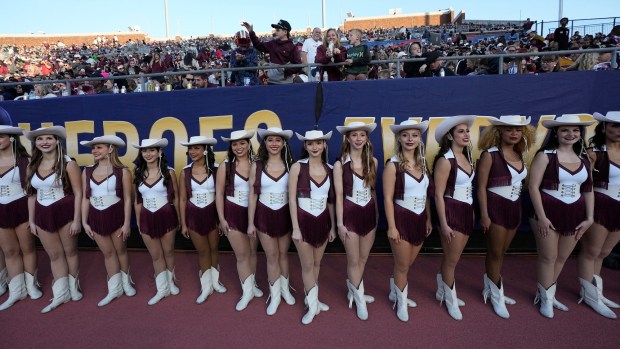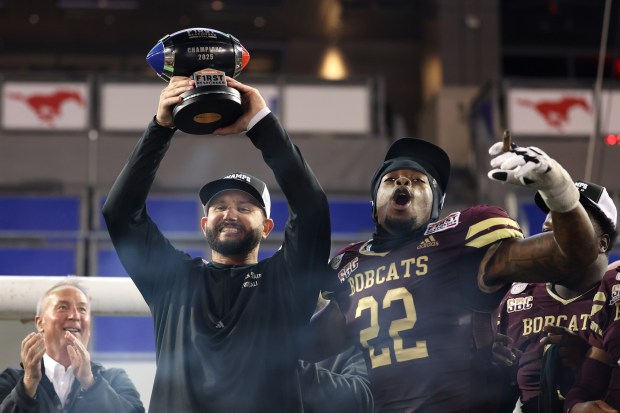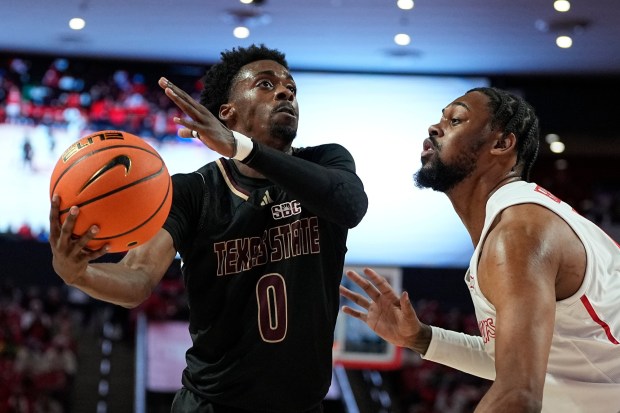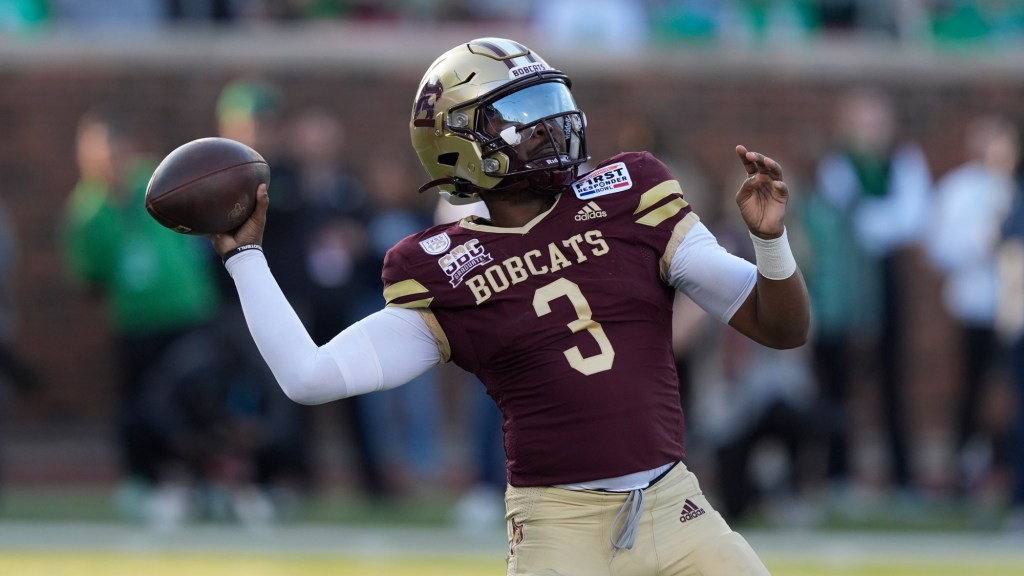It’s Texas State University, not Texas State University-San Marcos or Southwest Texas State Normal School or another of the seven titles it’s had since opening in 1903.
Texas State is acceptable on second reference, or TXST. But, according to its university style guide, “never use TSU.”
The mascot is Boko the Bobcat, the selection from a student naming contest in 1964 that netted $5 for the winner from Luling, Texas. The official colors are maroon and gold.
It is in the city of San Marcos, on a bluff above the San Marcos River in Texas Hill Country.
The most famous alum is President Lyndon B. Johnson, who attended what was then Texas Southwest Texas State Teachers College in the late 1920s, living in a tiny room above a professor’s garage, showering at the gym down the street and working, according to his 1965 speech at his alma mater, “a dozen different jobs, from sweeping the floors to selling real silk socks.”
It has 36,206 undergrads and 40,678 total students now, the seventh-largest university in Texas, and students presumably don’t sweep floors and shower in the gym.
This is the newest member of the Pac-12, made official Monday morning by the Texas State board of regents after a formal invitation was extended last week to a school 1,000 miles from the conference’s Pacific Ocean namesake.
But the Pac-12 needed an eighth, full member by July 1 to qualify for the College Football Playoff, and Texas State needed to leave the Sun Belt Conference by July 1 or face a doubled exit fee from $5 million to $10 million. It was a marriage, then, born from desperation and deadlines.
 Texas State dancers line up before half time during the First Responder Bowl NCAA college football game Friday, Jan. 3, 2025, in Dallas. (AP Photo/LM Otero)
Texas State dancers line up before half time during the First Responder Bowl NCAA college football game Friday, Jan. 3, 2025, in Dallas. (AP Photo/LM Otero)
Texas State was not among the leading candidates for Pac-12 expansion when 10 of the 12 previous members bolted for power conferences last year. Remnants Oregon State and Washington State convinced San Diego State, Boise State, Colorado State and Fresno State to defect from the Mountain West, then pursued four schools from the American Athletic Conference.
When Memphis and its AAC brethren balked, the Pac-12 grabbed a fifth Mountain West school in Utah State over a hectic few days last September while the Mountain West kept UNLV and Air Force with promises of outsized payouts from the close to $150 million it’s due in exit and poaching fees.
The Mountain West reportedly recruited Texas State as a replacement for the so-called “Pac-stabbers,” but President Kelly Damphouse correctly read the realignment tea leaves, knowing the Pac-12 would need an eighth full member that plays football. (Gonzaga, which brings value in basketball but doesn’t play football, doesn’t count toward CFP inclusion.)
“Pac2+5 will spin Texas State addition in a positive light, as they should,” former Salt Lake Tribune columnist Steve Luhm, who covered the Mountain West from its inception, wrote on social media. “In reality, it’s not anything close to what the ringleaders had in mind when they broke up the MWC. It is back-filling with an option none of them even considered before hitting the implosion button.”
So what, exactly, is the Pac-12 getting?
They’re getting a growing athletic department at a growing university in one of the nation’s fastest-growing cities along the growing Interstate 35 corridor between Austin and San Antonio. They’re getting potential more than present relevance.
“They would be considered a growth stock,” one Pac-12 source said.
The athletic budget last year, according to the Knight Foundation’s College Athletics Database, was $47 million and operated at a $3.4 million deficit. Nearly 80% was subsidized by institutional support (state tax dollars), student fees or donations. Student fees accounted for a whopping $20.1 million.
The $47 million ranks last among the eight football-playing members of the Pac-12 – only Utah State and Fresno State are below $65 million – and about half of SDSU’s budget, making even a partial Pac-12 share to start a welcome infusion of cash after getting an estimated $2 million per year from the Sun Belt.
 Texas State coach G.J. Kinne lifts the trophy and celebrates with Kalil Alexander after defeating North Texas at Gerald J. Ford Stadium on Jan. 3 in Dallas. (Sam Hodde/Getty Images/TNS)
Texas State coach G.J. Kinne lifts the trophy and celebrates with Kalil Alexander after defeating North Texas at Gerald J. Ford Stadium on Jan. 3 in Dallas. (Sam Hodde/Getty Images/TNS)
The Bobcats, though, have done more with less. Their football team has been to two straight bowl games after a pair of 8-5 seasons under coach G.J. Kinne, and the Bobcats finished 112th in the 2024-25 Learfield Directors’ Cup standings that annually ranks athletic departments across all sports. That’s better than six Mountain West schools, including Fresno State at 138th and SDSU at 157th.
The basketball program has had less success, reaching only two NCAA Tournaments in its Division I history and none since being a No 16 seed 1997 and losing 78-46. The Bobcats have gone 16-16, 17-18 and 16-19 in the last three seasons, finishing 194, 180 and 190 in the Kenpom metric. Average home attendance last season was 1,533 with no crowd over 2,523.
“I cannot wait to see some of these opponents come to San Marcos,” Keff Ciardello said on his “Win Now or Get Bent” podcast about Texas State athletics. “Gonzaga for basketball, that’s going to be fun. They’re going to come whoop on the Bobcats, but we’ll all be there, happy to see them, you know? ‘Thank you, sir, may I have another’ type of deal on that one.”
The university has invested in athletic facilities. Strahan Arena for basketball and volleyball was renovated in 2018 and has a capacity of 10,000. Upgrades to football’s Bobcat Stadium, the site of fictional TMU (Texas Methodist University) in the “Friday Night Lights” television series, doubled seating to 30,000 and added luxury boxes. Bobcat Ballpark holds 2,500 for baseball.
It’s not just the athletic department that has lofty ambitions. In May, Texas State unveiled a master plan that has enrollment climbing to 50,000 by 2033 along with the construction of 30 new facilities on the 500-acre main campus. There’s also a 100-acre satellite campus in Round Rock north of Austin, and an additional 4,000 acres of agricultural, research and recreation areas.
 Texas State guard Dylan Dawson (0) is defended by Houston forward J’Wan Roberts (13) during the first half of an NCAA college basketball game, Thursday, Dec. 21, 2023, in Houston. (AP Photo/Kevin M. Cox)
Texas State guard Dylan Dawson (0) is defended by Houston forward J’Wan Roberts (13) during the first half of an NCAA college basketball game, Thursday, Dec. 21, 2023, in Houston. (AP Photo/Kevin M. Cox)
Forty percent of students identify as Hispanic, recently passing whites (37%) as the majority. The acceptance rate is 89%, and U.S. News & World Report ranks it 152nd among public schools and 273rd among national universities in overall excellence. (SDSU is 52nd and 109th, respectively.)
Other notable alums include baseball’s 2022 National League MVP Paul Goldschmidt, two-time Super Bowl champion wide receiver Ricky Sanders and country music megastar George Strait.
After serving four years in the Army, Strait enrolled at what was then Southwest Texas State University to study agriculture, with an eye toward managing the family’s cattle ranch. His career path took a turn later that year when he auditioned for the lead singer of a local band named Ace in the Hole.
The question now is whether his alma mater can become the Pac-12’s ace in the hole.
Originally Published: June 30, 2025 at 9:04 AM PDT
